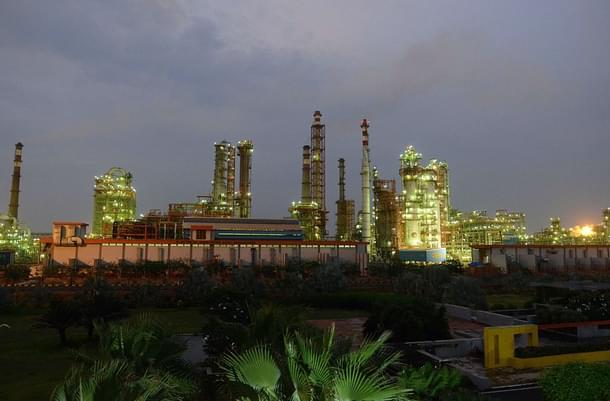Economy
Budget 2020 And The Netback Effect: Why Extended Periods Of High Oil Prices Are Unlikely
Venu Gopal Narayanan
Jan 16, 2020, 03:47 PM | Updated 04:01 PM IST
Save & read from anywhere!
Bookmark stories for easy access on any device or the Swarajya app.


As Union Finance Minister Nirmala Sitharaman and her team prepare to deliver a new budget, the eyes and calculations of both that department, and analysts, will focus most on the price of a solitary commodity: crude oil.
For a nation so heavily dependent upon crude oil imports (edging up to 80 per cent now), where cheap energy is everything, it’s a simple correlation: if international oil prices hold steady, then it will be a good year; if not, then we are up the creek without a paddle.
Fortunately, there is good news.
The prevailing environment indicates that an extended period of high oil prices over the coming year appears to be a low probability, because price spikes are presently constrained by shrinking demand growth and profit margins, particularly in North America.
The reasons for this prediction are myriad and technically abstruse, but in the end, they boil down to what oilmen call ‘the netback price’.
For India, it means that a working assumption of a $65-75 price band, for financial year (FY) 2020-21, would not be too off the mark, irrespective of political turbulence in the Middle East.
The standard definition of ‘netback price’ is the cumulative cost of dispensing one litre of petrol at a petrol pump. This includes all the costs incurred by all entities across all four parts of the oil chain — exploration and production, transportation, refining, and distribution and marketing.
Netback pricing is a dirty word, and for the longest time, oilmen refused to acknowledge its existence — even when the rubber hoses and narco-analysis kits came out in the torture room.
But it exists, remains the golden yardstick for measuring profits in the oil industry, and now, has potentially ameliorative implications for the Indian economy. That is why it is important for Indians to better understand this rarely-discussed aspect of an infamously-recondite industry.
It manifested itself most recently, when the oil price first refused to jump sky high, when the Americans assassinated Iranian General Qasem Soleimani, and then again, when prices resolutely declined to spike northwards, even after the Iranians lobbed missiles in retaliation, at an American military base in Iraq.
Instead, Robert Yawger, director of energy futures at Mizuho, in New York, complained morosely that his sector was ‘just getting killed’.
Why is that?
The reason is that rising crude oil prices reduce refining margins. American refiners, long-accustomed to minting money by processing foreign crude procured at discounts, are now finding it difficult to achieve such profit levels with the prices required to produce domestic oil in large volumes.
This latter constraint, which sets the floor price, is a function of the cost involved in extracting oil from tighter geological formations using advanced technologies. What this means is that such margins are setting a cap on the oil price.
The mournful confessions are getting increasingly more candid in America: “It's hard for crude oil to go higher if refiners continue to lose money or at best break even on gasoline,” says Tom Kloza, global head of energy analysis at the Oil Price Information Service (OPIS).
How does that work?
The answer is that Americans expect to purchase a gallon of petrol for around $3, just as American oil companies expect a $50-60 band for the domestic oil boom they presently enjoy. Anything more, and there would be riots in the streets; anything less, and there would be an epidemic of corporate suicides.
To make matters worse, improved fuel efficiency, energy conservation efforts, and a glut of oil are raising petroleum stockpiles to record highs. These problems are set to be compounded by the recommencement of work on the Keystone XL pipeline, from Alberta in Canada to the US Midwest and Gulf Coast, which would add another million barrels of cheaper Canadian crude oil a day to an already-oversupplied market.
So what’s the way out?
With domestic oil markets saturated to suffocation, the only way out is for North America to export as much of the excess crude oil they produce as they can — largely to Asia. And they cannot do that at a price above which, those very economies the Americans sell their oil to, start taking a beating.
So the crude oil price will fluctuate in a band between the floor price required to make North American oil production profitable, and a ceiling price beyond which North American crude becomes uncompetitive internationally.
Obviously, there will be a lot of geopolitics at work. Crises will be invented and defused. Countries like Venezuela and Iran will be politically ostracised so that the oil glut can be curbed. And trade deals will be negotiated with the ferocity of a hurricane. But little will blunt the truth of the oil price then remaining bound in an affordable band for the coming year.
For India, that means more money available for capital and social spending, a sterling opportunity to trim the deficit further, less outflow of foreign exchange, a smaller burden on the exchequer, and reduced inflationary tendencies. In other words — higher growth.
Thus, come Budget 2021, and there hasn’t been a long, painful period of high oil prices, remember you heard it first from Swarajya.
Venu Gopal Narayanan is an independent upstream petroleum consultant who focuses on energy, geopolitics, current affairs and electoral arithmetic. He tweets at @ideorogue.





